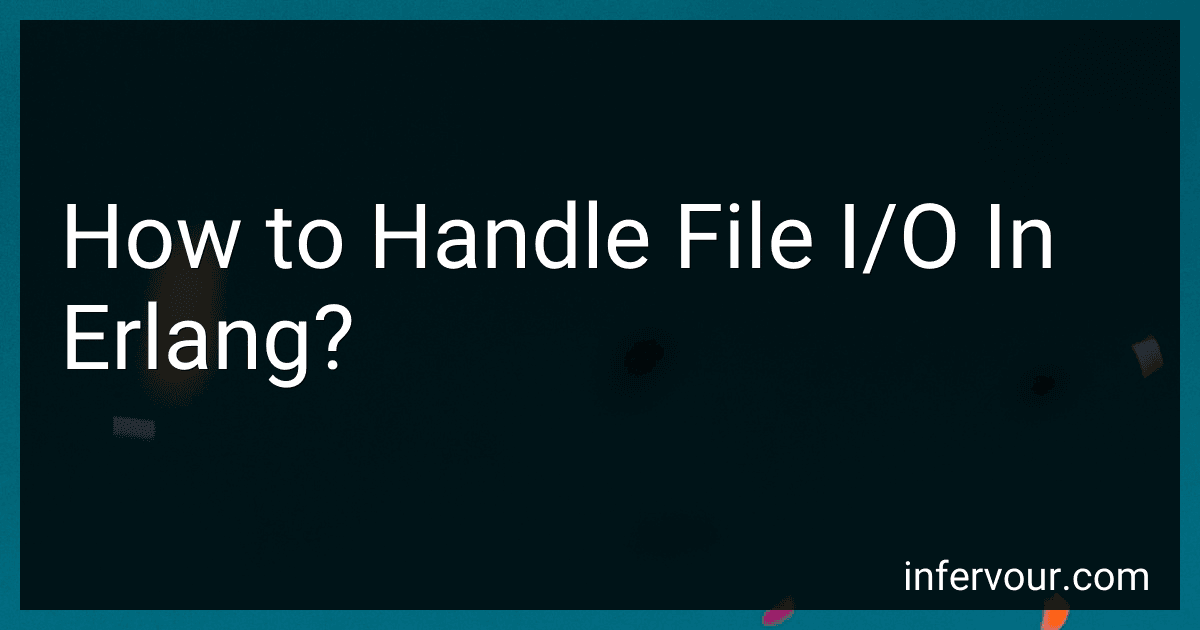infervour.com
-
 10 min readErlang is a powerful programming language that is widely used for building robust and scalable web applications. When it comes to web development, Erlang provides several features and tools that make it an excellent choice for building real-time and highly concurrent systems.One of the key features of Erlang is its support for lightweight processes, also known as actors.
10 min readErlang is a powerful programming language that is widely used for building robust and scalable web applications. When it comes to web development, Erlang provides several features and tools that make it an excellent choice for building real-time and highly concurrent systems.One of the key features of Erlang is its support for lightweight processes, also known as actors.
-
 8 min readDistributed systems refer to a network of computers working together as a single system, where tasks are executed across multiple machines to achieve high availability, fault tolerance, and scalability. Erlang, a functional programming language, is well-known for its built-in support for distributed computing.
8 min readDistributed systems refer to a network of computers working together as a single system, where tasks are executed across multiple machines to achieve high availability, fault tolerance, and scalability. Erlang, a functional programming language, is well-known for its built-in support for distributed computing.
-
 6 min readBinary data in Erlang is handled using the built-in binary data type and a set of functions provided by the Erlang standard library.Erlang represents binary data as sequences of bytes, which are stored efficiently in memory. This makes it suitable for handling tasks that involve reading, manipulating, and encoding binary data efficiently.
6 min readBinary data in Erlang is handled using the built-in binary data type and a set of functions provided by the Erlang standard library.Erlang represents binary data as sequences of bytes, which are stored efficiently in memory. This makes it suitable for handling tasks that involve reading, manipulating, and encoding binary data efficiently.
-
 6 min readFile I/O in Erlang allows you to read from and write to files in the file system. Here are the basic steps to handle file I/O in Erlang:Opening a File: To start reading from or writing to a file, you need to open it using the file:open/2 function. This function takes the filename as a string and the mode as an atom. The mode can be read, write, append, read_write, or write_append. Reading from a File: To read data from a file, you can use the file:read/2 or file:read_line/1 functions.
6 min readFile I/O in Erlang allows you to read from and write to files in the file system. Here are the basic steps to handle file I/O in Erlang:Opening a File: To start reading from or writing to a file, you need to open it using the file:open/2 function. This function takes the filename as a string and the mode as an atom. The mode can be read, write, append, read_write, or write_append. Reading from a File: To read data from a file, you can use the file:read/2 or file:read_line/1 functions.
-
 7 min readIn Erlang, modules are used to group related functions together. Creating and using modules in Erlang is straightforward. Here is a step-by-step guide:Start by creating a new file with the .erl extension. This file will serve as your Erlang module. Begin the module by defining its name using the -module(ModuleName). directive, where ModuleName is the desired name of your module. This directive should be the first line in your file.
7 min readIn Erlang, modules are used to group related functions together. Creating and using modules in Erlang is straightforward. Here is a step-by-step guide:Start by creating a new file with the .erl extension. This file will serve as your Erlang module. Begin the module by defining its name using the -module(ModuleName). directive, where ModuleName is the desired name of your module. This directive should be the first line in your file.
-
 9 min readCreating and supervising processes in Erlang/OTP involves using the built-in mechanisms provided by OTP to ensure fault tolerance and scalability in distributed systems. Here is an overview of the process creation and supervision in Erlang/OTP:Process Creation: In Erlang, processes are lightweight and isolated units of computation. They communicate by sending messages to each other.
9 min readCreating and supervising processes in Erlang/OTP involves using the built-in mechanisms provided by OTP to ensure fault tolerance and scalability in distributed systems. Here is an overview of the process creation and supervision in Erlang/OTP:Process Creation: In Erlang, processes are lightweight and isolated units of computation. They communicate by sending messages to each other.
-
 6 min readWorking with processes and concurrency in Erlang is a fundamental aspect of the language that enables robust and scalable applications. Erlang's lightweight process model allows for the creation of thousands or even millions of concurrent processes. Here's a brief overview of how to work with processes and concurrency in Erlang:Process Creation: In Erlang, processes are created easily using the spawn or spawn_link built-in functions.
6 min readWorking with processes and concurrency in Erlang is a fundamental aspect of the language that enables robust and scalable applications. Erlang's lightweight process model allows for the creation of thousands or even millions of concurrent processes. Here's a brief overview of how to work with processes and concurrency in Erlang:Process Creation: In Erlang, processes are created easily using the spawn or spawn_link built-in functions.
-
 4 min readRecursion in Erlang is a powerful technique that allows a function to call itself repeatedly until a certain condition is met. Here's a brief overview of how to use recursion in Erlang:Define a base case: Every recursive function needs a base case, which specifies when the recursion should stop. This base case is typically an if statement or pattern match that checks for a specific condition. When this condition is met, the recursion stops and the result is returned.
4 min readRecursion in Erlang is a powerful technique that allows a function to call itself repeatedly until a certain condition is met. Here's a brief overview of how to use recursion in Erlang:Define a base case: Every recursive function needs a base case, which specifies when the recursion should stop. This base case is typically an if statement or pattern match that checks for a specific condition. When this condition is met, the recursion stops and the result is returned.
-
 5 min readIn Erlang, errors and exceptions are handled using a combination of error codes and try-catch constructs. When errors occur, they are usually signaled by returning an error code or throwing an exception. The error handling mechanism allows for the separation of normal execution flow from error handling code, improving the robustness of Erlang programs.
5 min readIn Erlang, errors and exceptions are handled using a combination of error codes and try-catch constructs. When errors occur, they are usually signaled by returning an error code or throwing an exception. The error handling mechanism allows for the separation of normal execution flow from error handling code, improving the robustness of Erlang programs.
-
 6 min readPattern matching is a fundamental concept in Erlang, allowing developers to match and manipulate values in a concise and powerful way. Here's a brief explanation of pattern matching in Erlang:Basic Syntax: In Erlang, pattern matching is performed using the "=" operator. It is used to match patterns on the left-hand side with values on the right-hand side. Matching Atoms: Atoms are simple, constant values in Erlang. To match an atom, simply write its name. For example: atom = atom.
6 min readPattern matching is a fundamental concept in Erlang, allowing developers to match and manipulate values in a concise and powerful way. Here's a brief explanation of pattern matching in Erlang:Basic Syntax: In Erlang, pattern matching is performed using the "=" operator. It is used to match patterns on the left-hand side with values on the right-hand side. Matching Atoms: Atoms are simple, constant values in Erlang. To match an atom, simply write its name. For example: atom = atom.
-
 5 min readWorking with lists and tuples in Erlang is a core aspect of the language. Lists and tuples are both fundamental data types in Erlang and have their own unique characteristics and uses.Lists:Lists in Erlang are represented by a sequence of elements enclosed in square brackets.Elements within a list can be of any type, including atoms, numbers, other lists, or tuples.
5 min readWorking with lists and tuples in Erlang is a core aspect of the language. Lists and tuples are both fundamental data types in Erlang and have their own unique characteristics and uses.Lists:Lists in Erlang are represented by a sequence of elements enclosed in square brackets.Elements within a list can be of any type, including atoms, numbers, other lists, or tuples.